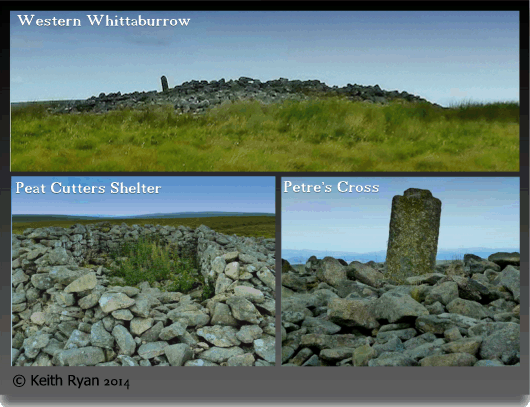
Having already posted a page on Eastern Whittabarrow it only seems logical to do the same for Western Whittaburrow. This also kills two birds with one stone as the cairn is also home to Petre’s Cross so you get two for the price of one.
Depending on what is referred to Western Whittaburrow is also known as Western Whitaburrow, Western Whittabarrow, Petre’s Tor and as the Ordnance Survey would have it – Western White Barrow. Which ever name takes your fancy they are all referring to a Bronze Age cairn albeit converted to serve as a later shelter. The monument measure 21m by 17.5m and reaches a height of about 1.7m and is situated atop of a broad, flat hill at a height of 477m above sea level According to Google Earth the monument is discernable from a height of around 8 kilometres when looking down from above. On a landward basis the prominence of Western Whittaburrow is further accentuated by the fact that on a clear day it is visible from Cosdon Beacon, some 25 kilometres away on the North Moor.
During the 1840s the Shipley Bridge Naptha Company were busy extracting peat in order to produce their naptha. Most of the men working on the turf ties around Red Lake Mires lived at South Brent which as the crow flies is some 7 kilometres away. This meant that the peat cutters would live on the moor during their working week which at the best of times was no pleasant prospect. In order to make their lives more comfortable they decided to build a shelter near to where they were cutting the peat. The temptation to use the nearby cairn as both a location and handy source for building materials was too great and so a small house was constructed at its centre. The two roomed building measured 11.5 by 4.7 metres and was complete with a fireplace and supposedly a slate roof, Butler, p.159. Unfortunately the Shipley Bridge Naptha Company ceased trading not long after the construction of the shelter and a few years later was partly demolished. The slate roof was taken away by the owner of Brent Moor manorial rights, Mr. Meynell for a spot of recycling. As a small aside to the life of the peat cutters, it is recorded that their bedding consisted mainly of dry heather and straw which certainly would have made for a scratchy sleep, Crossing, 1990, p.372. The other problem they faced was when their food supplies ran out mid-week, it was not as if they could just pop down the local Tesco Express. However, they did have the luxury of fresh rabbit which was poached from the nearby Huntingdon rabbit warren. Such was their liking for rabbit that a times it was not unusual to see a good dozen or so rabbits boiling in the crock pot, Crossing, 1974, p.35.

Many thanks to Keith Ryan for allowing me the use of these photographs taken from his Dartmoor Cam website.
Next we come onto the remnants of Petre’s Cross which today sits on the edge of the cairn looking more like a tombstone than a cross. The reason for this is that it has been placed in the cairn upside down with the tenon which slotted into a socket stone being uppermost. Following the dissolution of the abbeys in the 1530s -1540s Sir William Petre acquired the lands of Buckfast Abbey amongst which was the Manor of Brent. In order to mark his lands belonging to Brent Manor four wayside crosses were erected, one of which was located on Western Whittaburrow. This cross became known as Petre’s Cross and explains why in some circles Western Whittaburrow was/is called Petre’s Tor. The rectangular remnants measure 0.8m high by 0.37m by 0.18m with the tenon accounting for a further 0.22m by 0.18m by 0.5m.
What actually associates the peat-cutters shelter on the cairn with the cross is the fact that it is supposed that it served as the lintel which sat over the fireplace. The builders simply knocked off the arms of the cross which in turn provided a suitable slab of granite for its intended purpose. There was once a story that the cross was re-discovered in the late 1890s by some Ordnance Surveyors lying in a factory building at Didworthy and it was they who were responsible for re-locating it to Western Whittaburrow, Crossing, 1987, p.17. There can be no question that the Ordnance Surveyors did locate the cross at sometime as there is clear evidence of their benchmark. As to when the cross was re-erected nobody seems to know.

Crossing, W. 1974. Crossing’s Amid Devonia’s Alps. Newton Abbot: David & Charles.
Crossing, W. 1987. The Ancient Stone Crosses of Dartmoor. Exeter: Devon Books.
Crossing, W. 1990. Crossing’s Guide to Dartmoor. Newton Abbot: Peninsula Press.
 Legendary Dartmoor The many aspects past and present of Dartmoor
Legendary Dartmoor The many aspects past and present of Dartmoor
